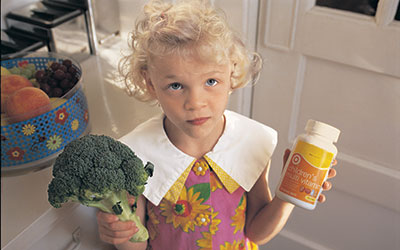In a country where nearly 30 percent of kids are either overweight or obese, it can be easy for parents to turn dietary fat into a boogeyman. But striving to remove all fats from your family’s meals would be a mistake.
“The key to fat is not the amount of fat, but the type of fat,” says Joel Fuhrman, MD, author of Disease-Proof Your Child: Feeding Kids Right. In short, not all fats are created equal. And certain types of fat – especially certain essential fatty acids (EFAs) like omega-3s and some omega-6s – are not only good for your kids, they’re critical to their development, immunity, mental development and physical well-being.
The trans fats (hydrogenated and partially hydrogenated oils) found in processed foods, as well as in many vegetable shortenings and margarines, are your worst enemy, because they increase your family’s risk of obesity, heart disease, diabetes and certain cancers, while delivering no redeeming nutritional value.
Saturated fats, like those naturally occurring in red meat and dairy products, should be consumed only in moderation. In excess (i.e., the standard American diet), they can have many of the same negative effects on health as trans fats.
But when it comes to all-around winning fats, a parent must look to monounsaturated fats (think olive oil, avocados, fish, nuts and seeds), which are high in omega-3 fatty acids. These EFAs are the “good” fats that not only help lower our blood cholesterol levels, but actually help facilitate many of our body’s natural processes, from blood-sugar regulation to brain function.
EFAs also have a protective function for our brains, cells, hearts, hormones and even moods, and they help to protect and strengthen growing bodies in general – a key reason EFAs are especially important for kids.
“Over the past few years, we’ve realized that fat isn’t just a source of calories for energy – it can actually turn genes on and off,” explains Jack Challem, nutrition researcher and author of The Inflammation Syndrome. “The right types of fat not only help build and operate healthy brains, they probably help turn on genes involved in brain development, which is why it’s that much more important for developing kids. And, if they develop poorly, the changes in the brain architecture could be permanent.”
Challem offers this metaphor: “If you are building a house and you work with shoddy materials, you’re not going to have a very solid structure.”
Pediatrician Christine Wood, MD, children’s nutrition expert and author of How to Get Kids to Eat Great and Love It!, concurs. “We know that the brain is 70 percent fat,” Wood says, “and omega-3 fatty acids, for example, are essential to fetal brain development during pregnancy.”
EFAs and Kids
For women who didn’t take omega-3-fortified prenatal vitamins during their pregnancies, there’s no need to despair. Although brain development does begin in utero, says Challem, omega-3 fatty acids are very important for brain maintenance and function throughout early childhood and later on, so parents should simply strive to make sure their kids consume omega-3s as early as possible.
Besides helping our brains, Fuhrman says, EFAs also help to develop hormones and regulate metabolism, are important to the structure and function of cell membranes, and, in particular, produce a strong immune system. That’s why an EFA deficit can contribute to everything from allergies to ear infections to asthma in young children.
Researchers have even discovered a link between mood disorders and a lack of omega-3 fatty acids in the body. Some data show that they help regulate mental-health disorders like ADD, ADHD and depression by enhancing the ability of brain-cell receptors to communicate with other neurons in the brain.
This is of particular significance for boys, who tend to suffer from mental disorders at a higher rate than girls. “Researchers found that boys with lower omega-3 fat levels in the brain were more likely to have learning and behavior problems,” says Wood, adding that males need two to three times the amount of EFAs as females.
In an interview with Ode magazine (July/ August 2006), famed French psychiatrist David Servan-Schreiber, MD, PhD, noted that when he prescribes EFAs to kids with learning disabilities, they learn twice as fast. “There isn’t a medicine on the market that can achieve that effect,” he notes. “It’s logical: 20 percent of the brain is composed of essential fatty acids we cannot make ourselves. If you don’t eat them, you don’t have them. Not on the plate, not in the brain.”
Balance Is Key
Ideally, in order for EFAs to work their magic, say nutrition experts, all of us, including kids, should be ingesting between a 3-to-1 and 4-to-1 ratio of omega-6 fatty acids to omega-3 fatty acids. (Some suggest that those with inflammatory diseases should aim for a 1-to-1 ratio.)
Yet the national average of omega-6s to omega-3s ranges from about 20 to 1 to 30 to 1, because the standard American diet simply contains an excess of omega-6 fatty acids, mostly from meat, dairy and cooking oils.
Most people, especially kids, get way too many omega-6s from the foods they eat and way too few omega-3 fatty acids, says Fuhrman: “Today, 90 percent of kids’ diets consist of calories eaten from processed food with omega-6 fats.”
Omega-6 fatty acids aren’t bad in and of themselves. In fact, certain types of omega-6s, like those found in borage oil, are terrific for us because they are rich in gamma linolenic acid, which has a variety of protective effects. Our bodies attempt to convert linoleic acid (the primary omega-6 fatty acid) into gamma linolenic acid, but in the presence of too much sugar and too many trans fats, and when we don’t eat enough omega-3s, our bodies are unable to make that conversion.
The problem, Challem explains, is that when omega-6s, which primarily aid the body’s immune system, outpace omega-3s, it throws the entire body out of whack. “Omega-6s are really the muscle for the body’s inflammatory response. They initialize the healing process, which is a good thing,” Challem says. “The problem is when they get the upper hand: They keep us inflamed all the time. This excess inflammation can give rise to autoimmune diseases, arthritis and heart disease, for example, and could also explain some behavioral disorders resulting from inflammation of the blood vessels in the brain.”
The good news, says Challem, is that “when you add omega-3s, you dampen down and counterbalance the effects of the omega-6s.” Increasing your children’s intake of omega-3s is as important as reducing the amount of trans fats in their diets. Trans fats not only offer your children zero nutritional value, they also disable the positive effects of EFAs, especially omega-3s.
“Picture a mother taking her 2-year-old and 4-year-old to McDonald’s to buy them chicken nuggets and French fries. These two foods, in particular, are just saturated in trans fats, which inhibit the enzymes involved in how the body processes both omega-6 and omega-3 fatty acids,” says Challem. “Twenty years ago, if you asked me what the most dangerous thing in our diet was, I would have said ‘sugar.’ Today, I say, ‘trans fats.'”
Even if you are ingesting the right balance of omega-3 and omega-6 fatty acids, says Challem, you won’t get the bang for the buck if you are also eating processed foods full of trans fats. The key to kids’ health, Wood agrees, is to cut trans fats from your children’s diets and to add in those healthy omega-3 fatty acids.
Getting the Good Fats
So the question is: How can you get more omega-3s into your kid?
The most potent source of omega-3 fatty acids is fish, says Challem. But if you find it difficult to entice your kids with sardine sandwiches for lunch, or if you’re concerned about toxins in many larger fish, Challem says, a daily teaspoon of fish oil is a perfectly fine substitute: “In the last three or four years, several companies have come out with orange- and lemon-flavored fish oils, so it’s a lot more palatable and easier to get down.” Once your child is 4 or 5 years old, he adds, you could switch to soft-gel fish-oil capsules that deliver the same potent omega-3 fatty acids. You could also supplement with flax, borage and other plant-seed oils.
The most important nutritional habit children can acquire, however, is eating “a mostly plant-based diet rich in omega-3 fatty acids,” says nutrition scientist Amy Lanou, PhD, author of Healthy Eating for Life for Children. Such a diet counterbalances the effects of excessive omega-6 intake (see sidebar, below) and, of course, steers clear of those nasty trans fats.
The basic game plan is straightforward: Feed your children more whole foods and avoid giving in to them in the grocery store – no matter how besieged you feel. Your child’s brain and body will reap the rewards.
More EFAs for Your Kids
Although essential fatty acids like omega-3s and select omega-6s are an integral part of your child’s health, the American Heart Association recommends that you keep total fat intake between 30 and 35 percent of calories for children age 2 to 3 and between 25 and 35 percent of calories for children and kids ages 4 to 18. Here are some tips for making sure healthy EFAs make up a decent part of that mix.
- Mash up avocados. “Avocados,” says author Joel Fuhrman, MD, “are a great EFA source for infants and children. They can be mashed with bananas and mixed with soymilks, tofu, beans or green vegetables.”
- Experiment with different oils. Nutrition scientist Amy Lanou, PhD, suggests cooking with oils that are rich in EFAs. Virgin canola oil is a good choice for everyday cooking, and olive oil is appropriate for light sautéing (though heating any oil to its smoking point negates its nutritional value). Seed and nut oils are an excellent source of good EFAs but are best kept refrigerated and drizzled over foods after cooking.
- Go nuts! One ounce of walnuts (about one-quarter cup) supplies slightly more (plant-based) omega-3 fatty acids than is found in 3 ounces of salmon. Fuhrman also suggests branching out from peanut butter and trying different kinds of nut butters. “When children obtain most of their EFAs from raw nuts and seeds, they are getting healthier fats,” he says. Be especially sure to grind up seeds and nuts for children ages 1 to 3, and if there is a family history of food allergies to nuts, hold off on introducing nuts and nut butters until age 3.
- Opt for pasture-fed meat and dairy. Meat, eggs and dairy products from grass-fed animals have two to four times more omega-3 fatty acids than meat from grain-fed animals, because grass is rich in those healthy fats. Omega-3-enriched eggs are an easy way to introduce your kids to EFAs.
- Sprinkle some flaxseed onto cereals or over a breakfast fruit-and-yogurt parfait. Flaxseed should be finely ground for maximum nutrient absorption, as the nutrients in whole seeds are not well absorbed by the body. Again, Lanou advises against cooking with flax oil, as it decreases the nutritional potency.
- Go easy on the tuna. If you are going the fish route, Lanou suggests reducing your child’s intake of tuna fish, as canned tuna has been found to contain high levels of mercury, which adversely affects children, as well as pregnant and nursing women.
- Teach them to eat like Popeye. Leafy green vegetables such as spinach and kale are excellent sources of omega-3 fatty acids. Involve your kids in making fun and creative salads that use these types of greens as a base.
This article originally appeared as “Kid-Friendly Fats” in the September 2006 issue of Experience Life.



This Post Has 0 Comments